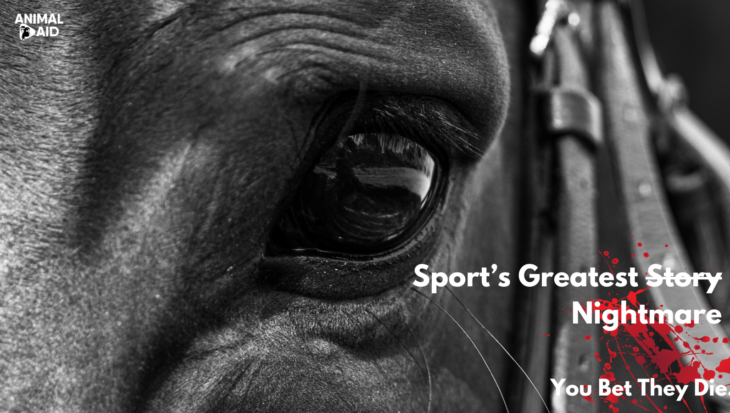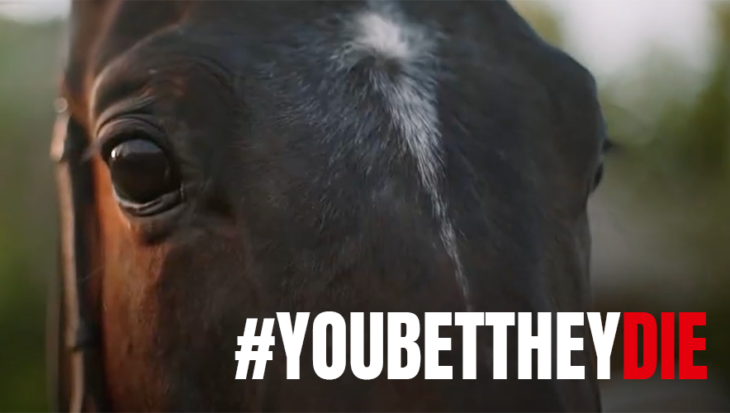Twenty-three horses perished at AW venues compared with seven during the previous year. Altogether, 178 horses were killed at Britain’s 60 racecourses in the past year, compared with 167 (see Note 1) in the previous 12 months.
The figures come from the second annual results of Race Horse Deathwatch, a unique online record of Thoroughbred fatalities on British racecourses launched in March 2007 by national campaign group, Animal Aid. While Jump racing showed a modest decrease overall (from 137 to 134), summer jumping events had a far more depressing record with 22 deaths – seven up on the year before.
The most lethal course, judged by the number of horses killed against the number of days’ racing it staged, was Sandown Park in Surrey. Seven horses died at the course in just nine days of racing. The course with the second most dishonourable record was Cartmel in Cumbria, which witnessed four fatalities in just six days of racing.
Of the All-Weather courses, Kempton Park came out worst of all, accounting for seven of the 23 deaths. Britain’s newest racecourse – the All-Weather Great Leighs in Essex – saw three deaths in its early meetings. Four of the five All-Weather courses have a ‘Polytrack’ surface – a rough mixture of sand, rubber and fibres. The exception is Southwell, which uses a Fibresand track. It had fewer deaths than the other four All-Weather courses, both in terms of total number of horses killed and deaths in relation to the number of racing days.
Given that most Thoroughbred racecourse victims are killed by a vet as opposed to dying outright from their injuries, the competence of the vet charged with destroying Thoroughbreds is vitally important. Animal Aid’s new Deathwatch report features a sequence of previously unpublished photographs, taken at Newton Abbot, which show an injured horse, called Ashby Jo, behind the traditional green screens, being pulled about roughly by a vet as he attempts to destroy him with a gun. The photographer who captured these rare images told Animal Aid that three shots were fired but that Ashby Jo was eventually despatched by a lethal injection. The nature of Ashby Jo’s death raises serious questions about the training of vets charged with the destruction of Thoroughbreds at racecourses.
Trainers, jockeys, owners, racecourse managers, clerks of the courses and veterinarians are all party to the carnage taking place on Britain’s racecourses, says Animal Aid. But most culpable of all, says the campaign group, is the British Horseracing Authority, the regulatory body charged with overseeing the welfare of horses who run under its Rules of Racing.
Says Animal Aid’s Horse Racing Consultant, Dene Stansall:
‘Time is fast running out for the British Horseracing Authority. If it continues to show an inability or unwillingness to produce remedies for the serious welfare problems that beset racing, then the pressure will grow for the government to strip it of its self-regulatory privileges and for the government itself to call the industry to account.’
Download Racehorse Deathwatch Year 2
Notes to editors:
- The original toll published in Race Horse Deathwatch Year One was 161. Six further deaths subsequently came to our notice and were verified. Our current totals for Year Two should similarly be treated as provisional. The final tally will probably be higher.
- Of the approximately 18,000 horses bred each year by the closely related British and Irish racing industries, only around 40% go on to race. Many of the ‘low quality’ newborns are destroyed while those who do enter racing suffer a high level of fatal injuries and stress-related illnesses, such as gastric ulcers and bleeding lungs. Around 7,000 race horses leave British racing each year, yet very few go on to a sanctuary or adoptive home.
- For Animal Aid’s analysis of the figures from the first year of Race Horse Deathwatch, see http://www.animalaid.org.uk/images/pdf/DeathWatchone.pdf
- View our powerful 90-second web film
More information:
- For full background and interviews, contact Andrew Tyler or Dene Stansall on 01732 364546.
- ISDN line available for broadcast-quality interviews.
- Images are available on request.

